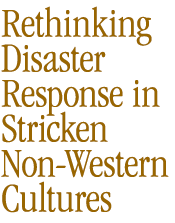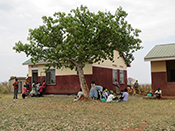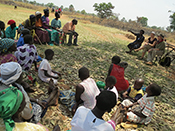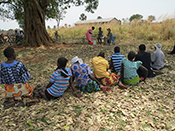
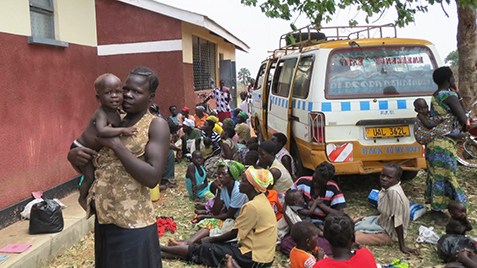
While working in northern Uganda following Joseph Kony’s violent war and the subsequent atrocities perpetuated by Lord's Resistance Army, disaster mental health responders discovered that traditional Western methods of treatment didn't work. What did work, however, was a researched approach known as “psychosocial capacity building,” now being put to practice in multiple ways by disaster responders and healthcare professionals being trained under the guidance of Smith College professors.
/ Published June 27, 2013
When disaster strikes—whether it’s in this country or in places like Sri Lanka, China, Haiti or northern Uganda—the recovery process unfolds differently from one region or culture to another, and healers coming to help must honor these differences if they want to be effective, according to disaster mental health responder Joshua Miller. He has come to recognize that the healing of human minds and spirits plays an essential part in rebuilding and reckoning with loss.
Miller, who is associate dean and professor at the Smith College School for Social Work, explains that the thread from the anti-oppression and anti-racism work he did earlier in his career now runs through the philosophical framework he is building around his work in disaster recovery today.
The approach that Miller employs is known as “psychosocial capacity building.” It is not so much a formula as it is an attitude that recognizes cultural strengths and differences when helping people and communities recover from events that turn their lives upside down.
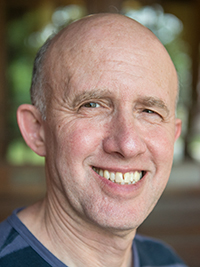
Joshua Miller. Photo by Jim Gipe.
Long interested in the field of disaster mental health and psychological first aid, Miller underwent a crisis of faith in 2004 when trying to apply Western psychotherapy principles in Sri Lanka after the devastating Indian Ocean earthquake, which killed more than 230,000 people in 14 countries. “There was all this stuff that I thought I knew but that doesn’t really fit with a non-Western culture,” says Miller. “For instance, I learned people there found it rude to share your feelings; it is considered like you are burdening the other person.”
What began as an inkling for Miller came into fuller focus when Professor Joanne Corbin, his colleague in the Smith School for Social Work, introduced him to Father Remigio Obol, a Catholic priest. Remigio’s church is in Awach—a village in Uganda’s Gulu District—where the notorious warlord Joseph Kony began his anti-government campaign in the late 1980s and terrorized his own people for almost two decades. Corbin brought Remigio to campus in 2006 as an outgrowth of her research into healing in the wake of atrocities perpetrated by Kony’s Lord’s Resistance Army, which had routinely kidnapped children and turned them into sex slaves and ruthless child soldiers.
Remigio was so impressed by the work Corbin and Miller did with Corbin’s project around psychosocial capacity building for mental health that he asked Miller to assemble a team to come to his area and use this approach to help build medical capacity in areas like HIV awareness, neonatal care and suicide prevention. Miller speaks of his deep respect and affection for Remigio, who was essential in providing daily guidance and insight into aspects of Ugandan culture and relationships.
Psychosocial capacity building (PCB), explains Miller, is “conceptually different” from traditional disaster mental health, which is often characterized by clinicians trained in Western principles of psychotherapy who swoop into a stricken area, counsel people to talk about their feelings and then leave. PCB, he says, “is more empowerment based, culturally responsive and collaborative.” It employs what Miller calls a “training of trainers model” —working with people in the community to develop tools and ideas that will be adapted and spread in ways that mesh with their own culture. This is not to say that one should ignore that some established ways of doing things have been permanently changed by the upheaval caused by a calamitous or violent event—whether an earthquake or, as in the case of northern Uganda, a civil war that drove 95 percent of the population into refugee camps for a generation. Loss has to be acknowledged and grieved, and people must recognize that the way forward will inevitably be different, reflecting the disruption. But unlike most scholars in this field, Miller doesn’t start from a premise that everyone—or even most people—who have been through a life-altering event have long-term trauma. Instead, he looks for sources of strength and resiliency rooted in the community.
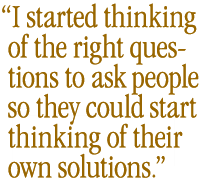
Miller says his time in northern Uganda profoundly influenced his evolving response to the way he saw disaster mental health practiced after the earthquakes in Sichuan, China, in 2008 and Haiti in 2010. His heavy involvement in both places helped shape his book Psychosocial Capacity Building in Response to Disasters (Columbia University Press, 2012). “I had already known from my anti-racism work that you don’t impose your culture on other people,” says Miller. “I stopped trying to impose what I thought I knew from the tradition of psychotherapy.... I realized that what I was really interested in was no longer disaster mental health, but working with people from different countries and different cultures....I started thinking of the right questions to ask people so they could start thinking of their own solutions.”
In response to Remigio’s entreaty to apply the ideas of PCB to rebuilding healthcare infrastructure in northern Uganda, Miller recruited two doctors, a nurse and a lawyer in Western Massachusetts to join him in finding ways to “stimulate resiliency” in Gulu and the surrounding area. They went for their second two-week visit this past February. A big part of their mission, says Miller, is to seek out local knowledge not just from health professionals but also from people who have their pulse on the daily doings of the community, like motorcycle taxi drivers, police officers and small business owners. They helped establish a local group called STEP-UP (Sustain, Train, Educate and Promote Uganda) to serve as a rallying point and funding vehicle. Initial projects included convening what Miller calls a “health camp” at a rural clinic (often a cinderblock structure with minimal equipment) to exchange ideas with Ugandan health workers. At the same time, Miller assisted with HIV counseling while a nurse tested patients for the virus. They also discussed how war-related trauma can lead to domestic violence and suicide, and provided training in neonatal care to midwives in conjunction with Helping Babies Breathe, an initiative of the American Academy of Pediatrics.
The Americans trained nine midwives in how to assess and rapidly address an infant’s problems with respiration in what the professionals call “the golden minute” immediately after birth. Timely identification and intervention can make the difference between life and death and can have a lifelong influence on brain function. Miller’s group then supervised those nine midwives as they trained nine more midwives. He sees “training of trainers” as a viral way of introducing knowledge and techniques that as they spread inevitably become reconfigured to reflect local cultural practices. “It is like a positive virus, building immunity in communities,” says Miller. “It is not just treating people, it is building capacity.”
Miller, heartened by the reception his group received, is looking forward to his next trip in February 2014. “We were warmly greeted wherever we went, and people really opened up to us because we respect what they know,” he says. “The feedback they gave us is that it is really different from when an NGO [non-governmental organization] comes in and just does a clinic and says, ‘this is how you do it’.” With medical capacity building, as with psychosocial capacity building, the key is listening and working towards culturally appropriate solutions to difficult local problems. The people his group is working with in northern Uganda told him, “You treated us as partners, and we felt like this was a collaborative process...that meant a lot to us.”
Every time he ventures out into the world to help others, Miller brings back ideas that shape his scholarship. “I’m a practitioner; there is not a separation between my research and my practice,” he says. “I try to extract lessons learned while at the same time using those lessons to help other people.”
After a Brutal War, What Will It Take to Heal Ugandan Society?
The “social” part of psychosocial capacity building is recognition that in many non-Western cultures individual well-being is more closely tied to collective or community strengths, while mainstream psychotherapy assumes a focus on the individual. In the case of northern Uganda, says Miller, the breakdown in what he calls “social trust” precipitated by a 20-year armed conflict makes other problems harder to solve. High rates of HIV infection, for example, are linked to a weakened clan system that controlled marriage and premarital sex.
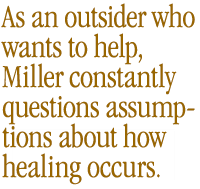
As an outsider who wants to help, Miller constantly questions his assumptions about how healing occurs. “I do not know Ugandan culture, in the way that Ugandans know their culture; they are the experts on how they grieve and mourn,” he says. “So I’ll ask questions about grieving and mourning and how they did it before the disaster...and what’s gotten in the way since the disaster.” The goal is a collaborative process in which he can help people solve problems in ways that recognize changed circumstances while thinking about culturally appropriate ways of reestablishing rituals.
His work with Joanne Corbin in northern Uganda has made Miller think about accountability in terms of how community members regard one another and the difference between “retributive” and “restorative” justice and the importance of settling grievances.
Healing Ugandan society, he has come to believe, will require a process of peace and reconciliation akin to what South Africa undertook after apartheid. Joseph Kony’s Lord’s Resistance Army was not an outside group, explains Miller; they were Acholis, the dominant ethnic group in northern Uganda. “If you were abducted as a child and forced to commit atrocities, then you are a victim and you also victimized people,” he says. “Everybody was either victimized or victimized other people or both; everybody was affected by this.”
Miller would like to see religious leaders and clan elders “work out a regionwide peace and reconciliation ceremony—a ritual that allows people to confess, allows people to forgive, allows people to make reparations,” adding, “It would have to build on traditional clan structures and people’s faith.”
He sees this kind of approach to conflict resolution to be in keeping with his ideas on creating a culture of well-being. “One of the things Joanne and I came up with was like a mantra,” says Miller, “without psychosocial healing there cannot be peace and reconciliation, and without peace and reconciliation there cannot be psychosocial healing.”













